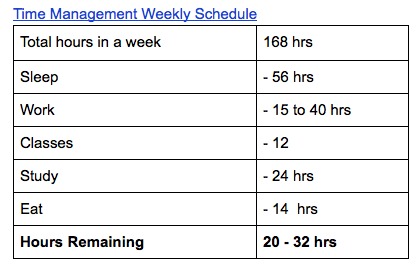Most public school districts in California schedule schooling hours between 7:00 AM – 3:00 PM five days a week for high school students. According to the National Center for Education Statistics, the average school day for public schools is 6.24 hours. Multiplied by 5 school days, that adds up to 31.2 hours weekly that students spend at school in class. On the other hand, a full course load for a full-time college student is 12 units (equivalent to 12 hours a week).
It doesn’t make sense that we ask high school students to spend more time in class than the average college student when we know that younger students have a smaller attention span and are also still developing in many different aspects: learning how to communicate, refining their motor skills, physically growing, and going through puberty, etc.
Here is a suggested weekly schedule that some colleges recommend to their students to manage their time:
There are high school and college students who have to work full-time jobs or are parents while in school but have responsibilities that are not considered in the hours listed above. 20 hours left in a week is not a lot for these students. School often comes in the way of the realities and needs of our lives that occur all the time such as going to the doctor, taking care of their health in other ways, spending time with their family, doing an internship, etc.
Since I started college, I have struggled tremendously to figure out how to follow a routine such as the one I mentioned above. Along with having time to deal with my health problems, making time for working out, learning how to cook healthy meals and other self care strategies that could have possibly prevented my health problems, spending time with family and friends, and extra curricular activities like student government and serving on a nonprofit executive board have been challenging for me. Students in high school should make better use of their time and be trained to manage their schedules instead of simply having to figure out all of this in college.
According to the Education Commission of the States, the California Education Code mandates that school districts choose their start and end time but are required to provide 175-180 days of instruction annually and a certain amount of hours for a day to be considered instructional. For grades four through twelve, the minimum requirement is four hours a day.
These 6.24 average hours should be reallocated in a different way and changed to shifting the structure of teaching. Some teachers are working with several classes of 20-30 students, sometimes having over 100 students preventing quality one-on-one time. Overall, most teachers are expected to create curriculum, teach their students, assign homework, provide additional help outside of class hours, work with students’ behaviors, and often provide parenting that students need because they spend all day at school. Imagine if teachers could host office hours the way professors do in college and better prioritizing the individual needs of students with one-on-one assistance.
We are not doing high school students justice by not being understanding that they too have a lot going on in their lives, and these long hour school days are not fit to help them manage or cope with the various stressors in our lives.
“While I was a student athlete, it became very hard to go home and do everything after practice: eating, homework, catching up on stuff on social media, spending time with my dogs, showering and sleeping. Ultimately, I had to choose track over being a part of a mentoring program,” said Jacqueline De Paz, 16, current high school student in San Bernardino, CA.
Instead, school districts can work with students, parents, teachers and principals to assess and better plan instructional hours and the resources the campus and community offer to engage students in developing a healthy lifestyle so when they become young adults who understand how to take of themselves instead of learning the hard way in college.
Rocio Aguayo
Latest posts by Rocio Aguayo (see all)
- Perspectivas desde Inland Empire: Como los Ingresos Afectan los Resultados de Aprendizaje en los Estudiantes - January 31, 2019
- Perspectives from the Inland Empire: How Income Impacts Student Learning Outcomes - January 30, 2019
- Luchadora Alex Beltran esta en un Empate Con el Titular de San Bernardino en el Consejo Municipal - December 4, 2018
- Luchadora Alex Beltran is Neck and Neck with San Bernardino Incumbent in City Council Race - December 4, 2018
- Los Jóvenes Pueden Hacer Una Diferencia en Esta elección, Incluso si son Demasiado Jóvenes para Votar - November 6, 2018


